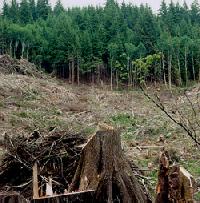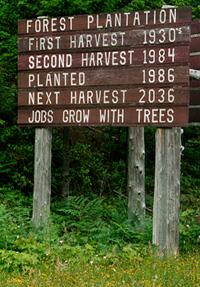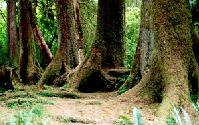July 18th, 1998
Should Trees Have Standing?
By Jackie Alan Giuliano, Ph.D.
You can hold yourself back from the suffering of the world: this is something you are
free to do ...but perhaps precisely this holding back is the only suffering you might be
able to avoid. -- Franz Kafka
At 9:30 pm last week, what sounded like a slow, loud thunderclap exploded through our
neighborhood. I could hear it through the open windows in my office at the back of our
house. We went out in to the street and saw an amazing and painful sight.
The wonderful tree at the end of the block that had cast such a nurturing shade on so much
of the street during its 80 - 100 year life time had just split in two. Half of the tree
had broken off and fallen into the street, blocking it entirely. An hour later, another
quarter of the remaining tree broke off. Upon close inspection, you could see that a rot
had crept into this venerable old tree, ending its life.
The street feels so bare now, so alone and exposed. But this sad sight is nothing compared
to what I saw just two weeks earlier during our vacation to Lake Crescent in Olympic
National Park in Washington State.
Just outside the national park, where the legally preserved lands turn into National
Forest jurisdiction, massive clearcuts appear as our future breaths are taken away by
greedy lumber companies - with the blessing of the United States government.

Clearcut in the Olympic National Forest. (All photos (c) Jackie Giuliano, 1998.
According to the World Wildlife Fund, 95% of the forests in the lower 48 states of
North America have been logged at least once.
The areas that have been clearcut have virtually every living thing removed from the land.
The trees of the remaining forest are now at risk as they experience exposure to the
elements that they never had before. Slowly, the death creeps inward, killing a much
larger area than that which was logged.
Some land is replanted and trees grow again, to be harvested at a later date. But these
areas are no longer the complex forests, filled with millions of life forms and complex
interactions that even the most complicated computer system cannot reproduce. What is left
is a tree farm, usually with only one species of tree. We do not know how to rebuild a
forest.
North American forests are among the richest on earth. Forests provide homes for over
one-half of the Earth's species and, in addition to providing products, they are the lungs
of our planet.
"Aren't those trees in National Forests protected," you may ask?
 Absolutely not. In fact, the U.S. government has a massive subsidy program in place that
allows the nation's lumber companies to buy trees on public lands - your lands and my
lands - for pennies.
Absolutely not. In fact, the U.S. government has a massive subsidy program in place that
allows the nation's lumber companies to buy trees on public lands - your lands and my
lands - for pennies.
You and I even pay for the roads that need to be built into these wild areas so these
private companies can get their equipment in. Most areas are in remote, mountainous
regions, so construction of new roads is expensive.
According to the Northwest Ecosystem Alliance (NEA) in Bellingham, Washington, the U.S.
General Accounting Office reports road construction costs from 1992-94 at nearly $245
million. The NEA says road building is also a major contributor to below-cost timber sales
which cost taxpayers $1 billion between FY92-94.
This year, you and I will pay for over 300 miles of new timber roads and 2,000 miles of
repaired logging access roads.
 But
America needs wood, right? We have to build our houses and repair the infrastructure of
our cities. And don't forget jobs. But
America needs wood, right? We have to build our houses and repair the infrastructure of
our cities. And don't forget jobs.
Well, it doesn't take much research to discover that a large number of the trees cut in
the U.S. are not even used here in this country! In 1997, 1.6 billion board feet of
softwood lumber were exported to other countries. Nearly 40 percent of that went to Japan
alone.
In the same year, over two billion board feet of whole logs were shipped to other
countries and 65 percent or 1.3 billion board feet of that went to Japan.
Japan is said to be hoarding uncut logs, storing them in hi-tech underwater storage
containers. When the U.S. is out of harvestable trees, guess who will be selling them back
to us?
It is so important to challenge the assumptions and beliefs we have all held sacred. The
truth is often very unsettling and painful. It is understandable to want to think that
everything is OK. Unfortunately, with the world under the control of millions of companies
who do not have to work together or worry about the future, we must be ever vigilant and
take back our power.

Trees grow from fallen tree trunks in the Olympic National Forest.
A forest is a vibrant and mysterious place that gives us the air we breathe. Every
fallen tree in an untouched forest is not a wasted "product." It is a vibrant
birthplace for new trees. Every inch of moss on a mountain waterfall is a mysterious
universe unto itself.
We need to appreciate the importance of a tree that is standing and expose the mythology
of the U.S. lumber industry, an industry that seems to be in business to export our
heritage and sell our future.
Don't let it happen.
RESOURCES
1. Learn more about the public cost of logging roads from the Northwest Ecosystem Alliance
at http://www.pacificrim.net/~nwea/
2. The World Wildlife Fund tracks worldwide forest decline. Check them out at http://www.worldwildlife.org/forests/overview.htm
3. Visit a panorama of a clearcut forest in Canada at http://geogweb.berkeley.edu/GeoImages/QTVR/VancouverIsland/NimpkishClearcutS.html
4. Learn more about the clearcutting problem from the Wilderness society at http://www.wilderness.org/standbylands/forests/paying.htm
5. Find your Congressperson and e-mail them. If you know your Zip code, you can find them
at http://www.visi.com/juan/congress/ziptoit.html
and tell them you want our forest resources managed for the future health of the planet,
not the immediate health of business. Tell them to stop exporting our trees.
6. In Canada, where the lumber industry operates without even the minor controls present
in the U.S., nearly 3 billion board feet of lumber was exported, 2.2 billion of which went
to Japan. Read about the lumber export business at http://www.randomlengths.com/samples.html#expdf
and select the "Random Lengths Export Example" to get a PDF file of the March
1998 EXPORT report.
7. Learn about the issues. Seek out books on the subject. A good source for used (and new)
books is Powell’s Bookstore in Portland, Oregon at http://www.powells.com/cgi-bin/associate?assoc_id=212
where you will find a wonderful alternative to the massive chain bookstores taking over
the market.
8. Visit the owlcam at http://members.aol.com/owlbox/nest98.htm
to see a family of owls living and raising their young. Remind yourself of the miraculous
cycles of life. Updated daily.
9. One of the most unique conservation organizations is The Nature Conservancy. Using
donations, they buy critical habitat and protect it forever! To date, they have preserved
10.2 million acres in the U.S. and 60 million acres in other parts of the world. Check
them out at http://www.tnc.org/involved/nsforms/work.html
|
